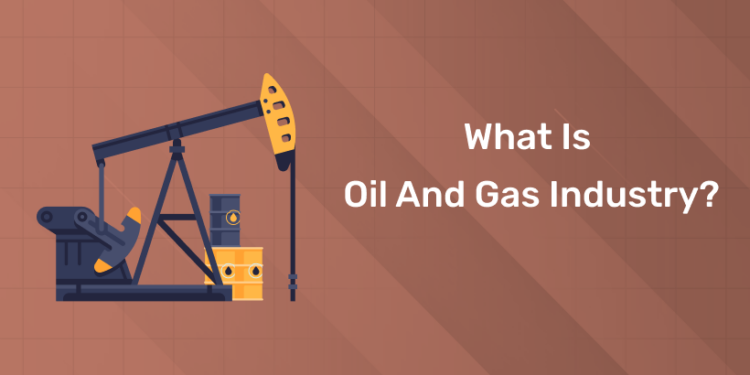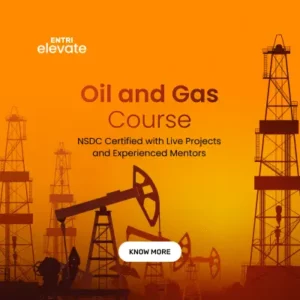Table of Contents
The oil and gas industry extracts and processes fossil fuels. It consists of exploration, drilling, and refining activities. Oil and gas are important for energy and transportation. Companies work globally, from offshore rigs to refineries. They provide fuels, lubricants, and raw materials for various products. Environmental concerns and regulations impact industry operations. Innovations aim to improve efficiency and reduce environmental impact. The industry faces problems like fluctuating prices and geopolitical issues. Further read this blog to answer the question: What is Oil and Gas Industry?
Get Certified! Get Confident! Join our Oil and Gas Course!
What is Oil and Gas Industry?
History and Evolution of the Oil and Gas Industry
-
Early Beginnings
- First Oil Well (1859):
- Location: Titusville, Pennsylvania, USA.
- Drilled by: Edwin Drake.
- Purpose: To extract oil for kerosene production.
- Initial Use:
- Lighting: Kerosene lamps replaced whale oil lamps.
- Heating: Used in stoves and heaters.
- First Oil Well (1859):
-
Growth and Expansion
- Automobile Era:
- Invention of the Car: Henry Ford’s Model T popularized gasoline engines.
- Increased Demand: Gasoline became a major product.
- Refinery Development:
- Fractional Distillation: Improved methods for separating crude oil.
- Industrial Scale: Expansion of refineries to meet demand.
- Automobile Era:
-
Strategic Resource
- World War II:
- Military Use: Oil fueled tanks, aircraft, and naval vessels.
- Strategic Importance: Control of oil resources became crucial.
- Technological Innovations:
- Enhanced Drilling: Development of efficient drilling equipment.
- Synthetic Fuels: Research into alternative fuels and materials.
- World War II:
-
Global Expansion
- Middle Eastern Discoveries:
- Major Fields: Discoveries in Saudi Arabia, Iran, and Iraq.
- Production Growth: Significant increase in global oil supply.
- International Influence:
- Multinational Companies: Rise of global oil corporations.
- OPEC Formation: Establishment of the Organization of Petroleum Exporting Countries.
- Middle Eastern Discoveries:
-
Energy Crises and Diversification
- 1970s Oil Crises:
- 1973 Embargo: OPEC’s embargo led to price spikes.
- 1979 Crisis: Iranian Revolution caused further supply disruptions.
- Energy Diversification:
- Alternative Energy: Development of solar, wind, and nuclear energy.
- Energy Efficiency: Focus on improving energy use and conservation.
- 1970s Oil Crises:
-
Technological Advancements
- Modern Drilling Techniques:
- Hydraulic Fracturing: Extraction from shale formations.
- Deep-Water Drilling: Exploration in deep ocean waters.
- Efficiency Improvements:
- Enhanced Recovery: Methods like steam injection and CO2 flooding.
- Automation: Use of digital technologies for efficiency.
- Modern Drilling Techniques:
-
Shift Towards Renewables
- Environmental Concerns:
- Climate Change: Impact of fossil fuels on global warming.
- Regulations: Implementation of stricter environmental regulations.
- Renewable Energy:
- Investment: Increased funding for renewable projects.
- Technology Development: Advances in solar panels, wind turbines, and storage.
- Environmental Concerns:
Leading global companies in the industry
1. ExxonMobil
ExxonMobil is a large, publicly traded oil company. It operates globally in exploration, production, refining, and marketing. The company invests in technology for better efficiency. ExxonMobil is involved in both upstream and downstream sectors. Its practices focus on sustainability and reducing environmental impact. The company’s global operations are driven by innovation. ExxonMobil aims to balance traditional and new energy solutions. It has a strong presence in the global market. The company’s technology and reach define its leadership. ExxonMobil’s extensive operations support its industry position.
2. Shell
Shell is a major global oil and gas company. Based in the Netherlands, it handles exploration, production, and refining. Shell also invests in renewable energy like wind and solar. The company focuses on reducing carbon emissions and environmental impact. Its diverse energy activities reflect a modern approach to energy. Shell’s commitment to sustainability is central to its strategy. The company operates worldwide, adapting to market changes. Shell’s role in renewable energy highlights its forward-looking vision. Its global presence supports a significant position in the industry. Shell continues to innovate and evolve with the energy landscape.
3. Chevron
Chevron is a leading U.S. oil and gas company. It works in exploration, production, refining, and marketing worldwide. The company excels in both conventional and unconventional energy. Chevron emphasizes technological advancements for efficiency. Its operations are driven by a focus on innovation. Chevron is committed to reducing environmental impact. The company invests in projects that balance energy needs with sustainability. Its global reach strengthens its market position. Chevron’s diverse activities span the entire energy sector. The company’s approach ensures continued growth and leadership.
4. BP
BP, based in the UK, is a major global oil company. It operates in exploration, production, refining, and distribution. BP is also investing in renewable energy sources. The company focuses on transitioning to cleaner energy. Its strategy includes balancing traditional oil and gas with sustainability. BP aims to reduce carbon emissions and environmental impact. The company’s global operations reflect its commitment to innovation. BP adapts to industry changes and environmental challenges. Its role in the energy market is significant. The company continues to evolve in a changing world.
5. TotalEnergies
TotalEnergies is a global energy leader based in France. It works in oil and gas exploration, production, and refining. The company also invests in renewable energy, such as solar and wind. TotalEnergies aims for a sustainable energy model. Its operations cover multiple energy sectors and regions. The company is committed to reducing environmental impact. TotalEnergies focuses on innovative technologies for energy transition. Its global presence and diverse portfolio define its industry role. The company continues to lead and adapt in a changing market.
Overview of Key Oil and Gas Markets
Contribution to Global GDP
-
Economic Significance
- Oil and gas contribute a large share to global GDP.
- Industry supports economic growth through production and trade.
- Essential for global energy supply and infrastructure.
-
Revenue Generation
- Oil and gas sales bring in substantial global revenue.
- High demand drives economic activity and income.
-
Employment
- Millions of jobs worldwide in oil and gas sectors.
- Supports roles in exploration, production, and refining.
-
Investment
- Significant investments in technology and infrastructure boost GDP.
- Drives economic development and innovation.
-
Trade Balance
- Oil and gas exports impact national trade balances.
- Key for economies dependent on energy exports.
-
Government Revenue
- Many countries rely on oil and gas for public funds.
- Taxes and royalties contribute to national budgets.
-
Economic Influence
- Oil price changes affect global economic stability.
- Industry performance influences global economic trends.
-
Technological Advancement
- Investment in new technologies enhances economic growth.
- Innovations drive efficiency and economic benefits.
-
Regional Development
- Oil and gas industries promote regional economic development.
- Creates infrastructure and business opportunities.
-
Energy Costs
- Oil and gas prices impact energy costs globally.
- Affects household and industrial energy expenses.
Technological Innovations
Advanced Drilling Techniques
Horizontal Drilling
- Access Multiple Zones: Drill horizontally to reach different layers.
- Increase Production: Tap into more resources from a single well.
Directional Drilling
- Precise Targeting: Directs drill to exact locations.
- Reduce Environmental Impact: Minimizes surface disturbance with accurate placement.
Managed Pressure Drilling
- Control Well Pressure: Adjust pressure to prevent blowouts.
- Improve Safety: Enhance control during drilling operations.
Enhanced Oil Recovery (EOR)
CO2 Injection
- Increase Recovery Rates: Inject CO2 to lift more oil.
- Reduce Oil Viscosity: Makes oil easier to pump.
Thermal Recovery
- Heat Application: Use steam or hot water to thin oil.
- Boost Heavy Oil Flow: Enhance extraction from thick crude.
Chemical Injection
- Improve Oil Flow: Add chemicals to increase mobility.
- Enhance Extraction Efficiency: Boosts oil recovery from reservoirs.
Digitalization and Automation
Remote Monitoring
- Real-Time Data: Collect data from sensors and devices.
- Operational Oversight: Monitor operations from a distance.
Predictive Maintenance
- Prevent Equipment Failures: Use data to foresee problems.
- Reduce Downtime: Schedule maintenance before issues arise.
Automated Drilling
- Minimize Human Intervention: Automated systems handle drilling controls.
- Optimize Operations: Adjust drilling parameters in real-time.
Seismic Imaging and Data Analysis
3D Seismic Imaging
- Detailed Subsurface Maps: Create 3D images of underground formations.
- Improve Exploration Accuracy: Better identify oil and gas locations.
4D Seismic Monitoring
- Track Reservoir Changes: Monitor changes over time in reservoirs.
- Optimize Resource Management: Adjust extraction strategies based on data.
Machine Learning
- Analyze Seismic Data: Use algorithms to interpret data.
- Identify Drilling Sites: Predict potential sites for drilling.
Environmental and Safety Technologies
Leak Detection
- Early Leak Detection: Sensors identify leaks quickly.
- Minimize Environmental Impact: Prevent spills and contamination.
Emission Reduction
- Lower Greenhouse Gases: Technologies to cut emissions.
- Enhance Environmental Compliance: Meet regulatory standards.
Safety Management
- Integrated Safety Systems: Combine data for safety improvements.
- Ensure Regulatory Compliance: Adhere to safety and environmental laws.
Renewable Energy Integration
Hybrid Power Systems
- Combine Energy Sources: Use traditional and renewable power together.
- Reduce Carbon Footprint: Lower emissions by using renewables.
Energy Storage
- Store Excess Energy: Save energy for times of high demand.
- Improve Reliability: Ensure continuous power supply.
Green Hydrogen
- Renewable Production: Make hydrogen using renewable energy sources.
- Lower Emissions: Reduce carbon footprint compared to fossil fuels.
Advances in Exploration and Drilling
Enhanced Exploration Techniques
3D Seismic Imaging creates detailed 3D maps of underground formations. It improves resource location accuracy with precise subsurface images. 4D Seismic Monitoring tracks reservoir changes over time for better strategies. Machine Learning Algorithms analyze seismic data efficiently, predicting drilling sites accurately.
Innovative Drilling Methods
Horizontal Drilling accesses multiple layers from a single wellbore. It maximizes resource extraction by drilling horizontally. Directional Drilling targets specific deposits, reducing surface impact. Managed Pressure Drilling controls wellbore pressure to prevent blowouts.
Automation and Digitalization
Remote Monitoring uses sensors for real-time drilling data collection. It provides immediate insights for better decision-making. Predictive Maintenance forecasts equipment failures, reducing downtime and costs. Automated Drilling Systems handle drilling controls, optimizing performance and consistency.
Environmental and Regulatory Challenges
Future Trends in Oil and Gas
1. Digital Transformation
Advanced Analytics
- Predictive Analytics: Forecasts equipment issues before they happen.
- Data-Driven Decisions: Uses real-time data for better choices.
2. Artificial Intelligence
- Automation of Tasks: Streamlines operations with AI technology.
- Enhanced Exploration: Improves resource detection with AI tools.
3. Internet of Things (IoT)
- Smart Sensors: Monitors equipment and environmental conditions.
- Remote Monitoring: Provides real-time operational data from afar.
Renewable Energy Integration
1. Hybrid Power Systems
- Combination of Sources: Blends traditional and renewable energy.
- Reduced Carbon Footprint: Lowers emissions with cleaner energy.
2. Energy Storage Solutions
- Battery Storage: Saves excess energy for high-demand periods.
- Enhanced Efficiency: Improves energy use and reliability.
3. Green Hydrogen
- Renewable Production: Creates hydrogen using renewable sources.
- Low-Emission Fuel: Offers a cleaner alternative to fossil fuels.
Environmental and Safety Innovations
1. Emission Reduction Technologies
- Carbon Capture: Captures and stores CO2 emissions.
- Cleaner Technologies: Reduces pollution with advanced systems.
2. Enhanced Leak Detection
- Advanced Sensors: Detects leaks more effectively.
- Automated Responses: Quickly handles leaks to minimize damage.
3. Safety Enhancements
- Real-Time Monitoring: Continuously checks systems for safety.
- AI-Driven Protocols: Uses AI to improve safety measures.
Decarbonization Efforts
1. Carbon Neutral Goals
- Net-Zero Emissions: Aims to balance emissions with offsets.
- Sustainable Practices: Incorporates sustainability into operations.
2. Renewable Energy Investments
- Infrastructure Development: Funds renewable energy projects.
- Diversified Portfolio: Expands into various renewable sources.
3. Green Technology Adoption
- Low-Emission Technologies: Uses technologies that cut emissions.
- Innovative Solutions: Implements methods to reduce carbon footprint.
The Evolving Role of Oil and Gas in the Global Energy Mix
Current Dominance
1. Major Energy Source
- Significant Share: Oil and gas are key global energy sources.
- High Demand: Essential for transportation, industry, and heating.
2. Economic Impact
- Revenue Generation: Major contributor to national and global economies.
- Job Creation: Provides numerous employment opportunities in various sectors.
Transition to Renewables
1. Diversification Efforts
- Investment in Renewables: Oil and gas companies are investing in renewable energy.
- Reduced Dependence: Gradual shift towards cleaner energy sources.
2. Hybrid Energy Solutions
- Blended Energy Mix: Combines oil and gas with renewable energy.
- Enhanced Efficiency: Optimizes energy use and reduces emissions.
Technological Innovations
1. Advanced Extraction Techniques
- Enhanced Recovery: New technologies improve oil and gas extraction.
- Efficiency Gains: Reduces environmental impact and operational costs.
2. Digital Transformation
- Smart Technologies: Uses AI and IoT for better management.
- Real-Time Data: Enhances operational efficiency and decision-making.
Environmental Considerations
1. Lower Emissions Goals
- Carbon Reduction: Efforts to lower emissions and improve sustainability.
- Cleaner Technologies: Adoption of technologies that reduce environmental impact.
2. Regulatory Compliance
- Stricter Regulations: Adherence to evolving environmental standards.
- Sustainability Practices: Integrates eco-friendly practices into operations.
Future Outlook
1. Evolving Energy Mix
- Balanced Approach: Integration of oil, gas, and renewables.
- Adaptation to Trends: Responds to changing global energy demands.
2. Long-Term Sustainability
- Carbon Neutral Goals: Aims for net-zero emissions in the long term.
- Innovative Solutions: Embraces new technologies and practices for sustainability.
Conclusion
1: What is the primary purpose of a refinery in the oil and gas industry?
In conclusion, the oil and gas industry remains vital globally. Technological advances and sustainability efforts are shaping its future. The industry focuses on reducing emissions and improving efficiency.
Frequently Asked Questions
What does the oil and gas industry involve?
- Exploration and extraction of crude oil and natural gas.
- Refining crude oil into usable products like gasoline, diesel, and jet fuel.
- Distribution and transportation of oil and gas products.
- Marketing and sale of petroleum products.
How is the oil and gas industry structured?
- Upstream: Exploration and production of oil and gas.
- Midstream: Transportation, storage, and wholesale marketing.
- Downstream: Refining, distribution, and retail of end products.
- Support services: Drilling, engineering, and construction.
Why is the oil and gas industry important?
- Powers transportation, manufacturing, and electricity generation.
- Provides raw materials for various products like plastics and chemicals.
- Major source of global energy supply.
- Significant contributor to national economies and job creation.
What are the environmental impacts of the oil and gas industry?
- Emissions of greenhouse gases contributing to climate change.
- Risk of oil spills and water contamination.
- Land disturbance due to drilling and extraction.
- Air and water pollution from refining processes.
What are the challenges facing the oil and gas industry?
- Fluctuating oil prices affecting profitability.
- Increasing regulatory pressure for environmental compliance.
- Transition to renewable energy sources.
- Managing operational risks and safety concerns.












